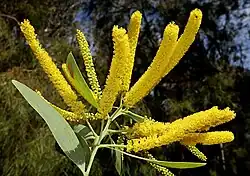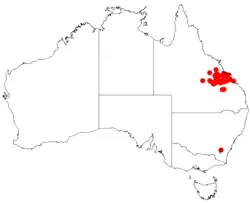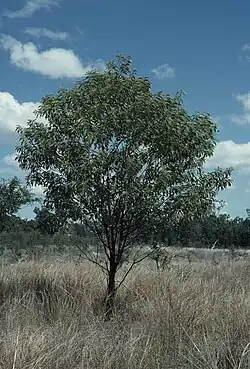Acacia cretata
| Acacia cretata | |
|---|---|

| |
| Scientific classification | |
| Kingdom: | Plantae |
| Clade: | Tracheophytes |
| Clade: | Angiosperms |
| Clade: | Eudicots |
| Clade: | Rosids |
| Order: | Fabales |
| Family: | Fabaceae |
| Subfamily: | Caesalpinioideae |
| Clade: | Mimosoid clade |
| Genus: | Acacia |
| Species: | A. cretata
|
| Binomial name | |
| Acacia cretata | |

| |
| Occurrence data from AVH | |
| Synonyms[1] | |
|
Racosperma cretatum (Pedley) Pedley | |

Acacia cretata is a species of flowering plant in the family Fabaceae and is endemic to Queensland, Australia. It is a single-stemmed shrub or tree with flattened branchlets, narrowly elliptic to elliptic phyllodes, spikes of bright yellow flowers and linear, glabrous pods raised over and constricted between the seeds.
Description
Acacia cretata is a single-stemmed, round-topped shrub or tree that typically grows up to 8 m (26 ft) high and has smooth bark at first, later rough and fibrous. Its branchlets are flattened, glabrous, angular, brownish crimson with a whitish bloom. The phyllodes are narrowly elliptic to elliptic, 70–140 mm (2.8–5.5 in) long and 17–40 mm (0.67–1.57 in) wide, abruptly narrowed into short, stout petioles. The phyllodes are leathery, silvery bluish grey to glaucous with a hooked tip, the lower edge sometimes continuous with the branchlet. The flowers are borne in spikes 40–120 mm (1.6–4.7 in) long and bright yellow, the spikes on a peduncle 7–25 mm (0.28–0.98 in) long. Flowering occurs between July and September and the pods are linear, 60–100 mm (2.4–3.9 in) long and 3–5 mm (0.12–0.20 in) wide, thinly crusty and glabrous, raised over and more or less constricted between the seeds. The seeds are black, oblong, 4–6 mm (0.16–0.24 in) long and 1.8–2.0 mm (0.071–0.079 in) wide with a yellow aril.[2][3][4][5]
Taxonomy
Acacia cretata was first formally described in 1969 by the botanist Leslie Pedley in Contributions from the Queensland Herbarium.[5][6]
Distribution
This species of wattle occurs in Queensland along the Great Dividing Range between Mara and Moranbah and is common on the Blackdown Tableland, where it grows in open forest in sandy, gravelly or loamy soils, usually over sandstone.[2][3][4]
Conservation status
Acacia cretata is listed as of "least concern" under the Queensland Government Nature Conservation Act 1992.[7]
See also
References
- ^ a b "Acacia cretata". Australian Plant Census. Retrieved 7 August 2025.
- ^ a b Tindale, Mary D.; Kodela, Phillip G. Maslin, Bruce R.; Kodela, Phillip G.; Orchard, Anthony E. (eds.). "Acacia cretata". Flora of Australia. Australian Biological Resources Study, Department of Climate Change, Energy, the Environment and Water: Canberra. Retrieved 8 August 2025.
- ^ a b "Acacia cretata". Australian Biological Resources Study. Retrieved 8 August 2025.
- ^ a b "Acacia cretata". WorldWideWattle. Western Australian Herbarium. Retrieved 9 October 2019.
- ^ a b Pedley, Leslie (1969). "Notes on Acacia, chiefly from Queensland, III". Contributions from the Queensland Herbarium. 4: 1–2. Retrieved 8 August 2025.
- ^ "Acacia cretata". APNI. Retrieved 7 August 2025.
- ^ "Taxon - Acacia cretata". Queensland Government, WildNet. Retrieved 8 August 2025.